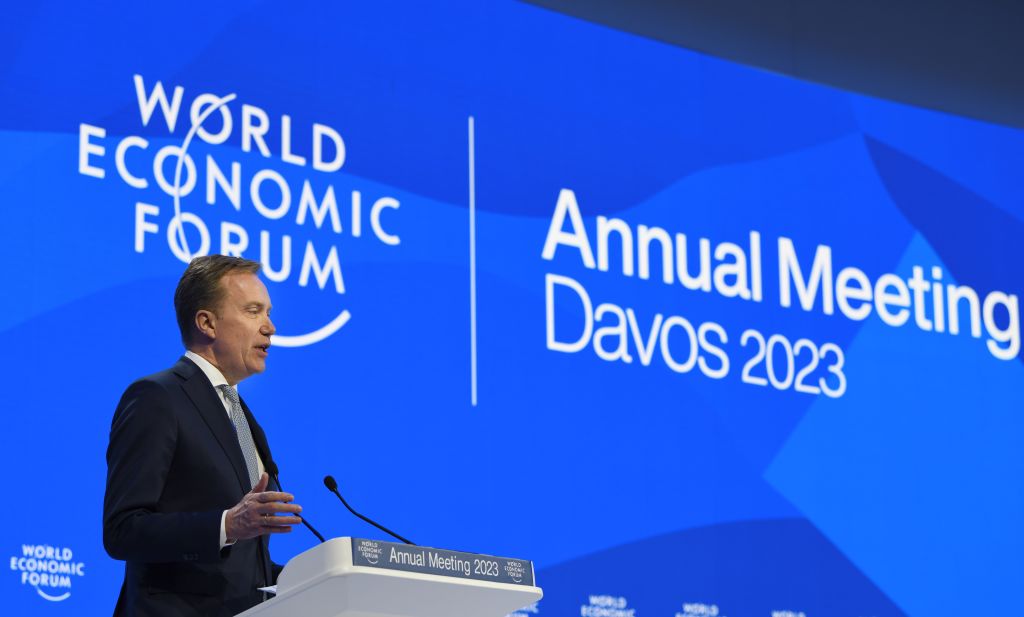The U.S. and Europe are the new sick men of the world.
Hacking the World

The prospect of thousands of "geoengineers" trying to save the planet could spell disaster.
Picture this. An entrepreneur with a history of investment in wacky environmental projects—everything from cold fusion to large-scale reforestation—decides to take matters into his own hands and restore dwindling fish stocks in the ocean off Canada’s west coast. His hope is that, by doing so, he can also help secure the livelihoods of the region’s downtrodden indigenous peoples, who rely heavily on the fish and have fallen on hard times. Maybe he can even do something about global warming while he’s at it.
He plans to stimulate a giant artificial algal bloom by dumping a huge amount of a particular chemical into the water, a few hundred miles out from the coast. The thinking is that a massive input at the bottom of the food chain (the chemical is a nutrient essential for algal growth) will have knock-on effects all the way up, via the smaller and larger fish, to the humans at the top.
The extra algae will make sure the fish, especially the salmon, that live off the coast will be well fed before they make their way inland to spawn. More are likely to survive, meaning more offspring will spawn, and this in turn will mean more fish for the local indigenous peoples to catch. The algae that aren’t eaten by the fish will act as a sink for large amounts of dreaded carbon, since plants, including algae, draw carbon dioxide from the atmosphere to produce energy via photosynthesis. When these surplus algae die, they’ll sink to the bottom of the sea, effectively sequestering the carbon in a place where it can’t readily get back into the atmosphere. If what you care about is biodiversity, the dignity and rights of marginalized peoples, and removing greenhouse gases from the atmosphere to prevent global warming, it’s pretty hard not to see this plan as a win-win-win. Our entrepreneur certainly thinks so anyway.
So he secures funding, gets together a crew and a big boat with lots of sophisticated equipment, buys the necessary chemical—then heads out to sea and dumps it, exactly as planned.
In fact, all of this happened a little over ten years ago. In 2012, entrepreneur Russ George, with a crew of 11 aboard the ship the Ocean Pearl, dumped 100 tons of iron sulfate into the water off British Columbia.
At the time, George was involved with a San Francisco-based startup called Planktos, whose mission was “ocean restoration.” He had consulted some of the indigenous residents of the Haida Gwaii islands and told them he could bring their precious fish back. He didn’t have anything like “official permission” and didn’t have much data to go off, except some small-scale experiments. But the plan seemed plausible, and so he decided to proceed.
When the Ocean Pearl returned to land, George didn’t receive the hero’s welcome he’d expected. Although it later transpired that the Canadian government had actually been working with George’s team in the years leading up to the dumping, the country’s environmental ministry had warned that such a venture, if it ever went ahead, would be in violation of international agreements, and no official approval was ever given. The Canadian National Resources Council had funded George, but “for research and development of technology that does not involve anything regarding dispensation of iron sulphate in ocean water,” a spokesman said. The Canadian government confiscated the expensive equipment it had given him and moved to prosecute.
It took some months for news of what George had done to become public, but when it did, scientists and environmentalists around the world rushed to condemn him for meddling carelessly, without anybody’s consent, with forces beyond his full comprehension or control.
George, though, was unrepentant and later claimed his plan had been a great success. Satellite imagery did indeed show that a massive algal bloom took place off the west coast of Canada, exactly where the iron sulfate had been dumped, and the Alaska Department of Fish and Game confirmed that 2013 brought a record salmon harvest. Judging George’s claims about carbon sequestration proved more difficult, if not impossible, however.
George was also lucky. Despite the widespread outrage at his actions, the Canadian authorities were unable to find a law to charge him under. Experts noted that he almost certainly hadn’t broken international law, simply because there were no appropriate laws under which to charge somebody for doing what he did. Edward Parson, a professor of environmental law, produced a detailed legal analysis of the event, arguing that any powers that existed under international agreements like the Convention on Biological Diversity and the London Convention on Ocean Dumping were purely advisory in nature, despite their strong wording and commitment to exercise “utmost caution and best available guidance” when it came to deliberate attempts at geoengineering—the name generally given to interventions to alter the earth’s climate—or “ocean restoration.” “Nations,” Parson stated, “are under no legal obligation to refrain from ocean fertilization research, nor to submit proposals to any international process.” While nations might one day seek legal controls on such activity, “there isn’t any legal control on it at present.”
Good news for George, who escaped prosecution, but bad news for us. Why? Because what we’ll call the “George Incident”—the first real attempt at private geoengineering—has just been repeated, and those legal controls are still nowhere to be seen.
This new attempt, by an American startup called Make Sunsets, is different from the George Incident in a number of worrying ways. Not least of all, it has the potential to be replicated on a large scale, in a decentralized, distributed manner, making it even more difficult to police and arguably much more dangerous. The company has confirmed it is now using cheap helium balloons to release reactive particles into the atmosphere, with the aim of global cooling. The first trial flights took place in Baja California, Mexico in April 2022, and the company’s CEO, Luke Iseman, plans to scale up operations significantly in the coming year. The company already has $750,000 seed capital and will allow people to purchase “cooling credits” that will pay for the balloons’ chemical payload. You can go on its website now and pay $10 to buy a credit, should you wish.
In short, geoengineering is going viral, and we’re no better prepared to deal with it than we were a decade ago.
Geoengineering has received increasing attention in recent years as one potentially very powerful method of fighting climate change. Even if you don’t follow the activities of the World Economic Forum, you may remember a video it posted last year that came dangerously close to the plot of a famous Simpsons episode (“Who Shot Mr Burns?”) In one of its more sensible suggestions, the WEF claimed that in the not-too-distant future giant “space bubbles” could be used to block sunlight from reaching the earth, thereby reducing the amount of heating that takes place. Where’s Maggie Simpson with a gun when you need her?
The technology for geoengineering the planet’s climate has been under increasingly serious consideration for at least two decades, as the so-called “Climate Crisis” has deepened. The idea of manipulating the weather, on a much more local scale, dates back to the 1960s at least. Weather warfare was actually used during the Vietnam War, for instance, as part of Operation Popeye. Nearly $3 million was invested in techniques such as cloud-seeding in an attempt to extend the region’s monsoon season and flood the Ho Chi Minh Trail, which was essential for supplying Viet Cong forces in South Vietnam with manpower and materiel. Between 1967 and 1968, it was estimated that the U.S. managed to increase rainfall over the Trail by 30 percent, with unknown effect on the Viet Cong’s operations.
While weather-modification techniques have received no small amount of attention as actual or potential weapons of war, the focus for the last 20 years, at least in public, has been on their benign uses, and on a planetary scale rather than in just a single region of the world or theater of combat. A wide variety of governmental and non-governmental organizations, including the U.S. Congress, UK Parliament, and the Royal Society have produced detailed research into geoengineering.
Generally, these bodies have all come to the same conclusion as the U.S. National Academy of Sciences, which released a two-part report on the technology in 2015. The Academy noted that reductions in carbon emissions should remain the priority in the future for tackling climate change, since the potential for “large-scale deployment” of geoengineering technology is still unknown and likely to be so for some time yet. The report also notes that the risks and possible side-effects are not well enough understood and need to be investigated. Until this necessary research into the potential benefits and dangers of the technology has been carried out, geoengineering should not be deployed on “climate-altering scales,” the report concludes.
The straightforwardness of the broad official agreement on future use of geoengineering hasn’t stopped fears about its use from multiplying. It’s not hard to see why. As much as we might have reason to fear a nation-state—say, China—exploiting geoengineering for its own selfish gain rather than that of humanity, the misuse of such technology by private actors has loomed equally large, if not larger. These fears were given a particularly memorable form by David Victor, a political scientist at the University of California, a few years before the George Incident. He described how “a lone Greenfinger,” referencing of course Goldfinger, the James Bond villain, “self-appointed protector of the planet and working with a small fraction of the Gates bank account, could force a lot of geoengineering on his own.”
Victor was right to point to the danger of the messianic impulse that so often seizes the very wealthy, not least of all because of what happened soon after with Russ George. But what Victor and others didn’t envisage is the widespread use of geoengineering by much humbler private actors, presumably since it was believed the technology would be beyond the means of all but the very wealthy (a boat, a crew of 11, and 100 tons of iron sulfate don’t come cheap). Only a 2018 white paper seems to have anticipated a more distributed approach to geoengineering, using materials that are readily available and largely inexpensive. What I should really say is “inspired” rather than “anticipated,” since the CEO of Make Sunsets, Luke Iseman, has confirmed he actually took the white paper’s warning as a template.
The white paper, published by the Harvard Kennedy School’s Belfer Center, warned of “highly decentralized nonstate deployment” of solar geoengineering technology, in the form of unmanned high-altitude balloons dispersing chemicals like sulfur dioxide. The authors of the white paper believed that this scenario would be more plausible than forms of “centralized nonstate deployment”—by larger NGOs or corporates—because “states will consider large-scale climactic alterations to be their prerogative, not that of nonstate actors.”
The barriers to entry for “decentralized nonstate deployment,” the paper notes, are flimsy. “Hobbyists have launched balloons, costing ~$25-50, that can carry ~5-10 kilograms (kg) to heights above 20 kilometers (km).” Such balloons are readily available online, and “their payload could include a few kilograms of sulfur dioxide,” which would cost around $5 a kilogram. The balloons would be designed to fail at a specified height, releasing their payload. Per balloon, then, we might be looking at a cost range of between $30 and $60—as little as the price of a hardback raw-egg cookbook, or bundle with the latest MAN’S WORLD Annual. The authors also anticipate the use of new decentralized technologies like blockchain and crowdfunding to fund and coordinate these efforts.
This is exactly the blueprint that Make Sunsets is now following. The high-altitude balloons, the sulfur dioxide payload, the crowdsourcing—everything, to the letter. The initial launches did not include telemetry or measuring equipment, so it’s unclear whether the balloons deployed their payload as intended, but the company plans to include such devices on future launches. The only thing that’s a poor fit with the blueprint is the corporate nature of Make Sunsets itself. According to the Harvard white paper, this model is better categorized as “moderately decentralized nonstate solar engineering.”
“What I want to do is create as much cooling as quickly as I responsibly can, over the rest of my life, frankly,” Iseman said after making news of the launches public. Make Sunsets will deploy as much sulfur in 2023 as “we can get customers to pay us” to release, he added. The company had planned to launch three more balloons in January alone, but not long after the announcement of the test launches, the Mexican government issued a statement saying it would “prohibit and, where appropriate, stop experimentation practices with solar geoengineering in the country.” The statement added that,
The opposition to these climatic manipulations is based on the fact that there are currently no international agreements that address or supervise solar geoengineering activities, which represent an economically advantageous way out for a minority and risky for the supposed remediation of climate change.
Shamed, in all likelihood, by the charge of “minority”—i.e., white Western—privilege above anything else, Make Sunsets issued a contrite response that noted it would place its operations in the country on hold and “review our approach.”
In truth, whether or not Make Sunsets ever launches another balloon—although its CEO and backers are confident it will—is beside the point. What really matters is where this is leading. The Make Sunsets operation would best be thought of, I think, as a bridge to the truly decentralized form of geoengineering described in the 2018 Harvard white paper. As I said in a piece of reporting on the initial announcement of the startup’s activities, “radical environmentalists will surely be paying close attention.” They will. Make Sunsets has shown the way, and others will surely follow—and I don’t mean startups, although there may very well be more of those.
One thing the Harvard white paper does badly is consider the motivations of ordinary environmentalists to engage in their own makeshift geoengineering. This is largely a function of the fact that the paper is an academic one, written from within political science, and so it has to address quite obvious questions, with obvious answers, in the stilted argot of the discipline. Why would “a large number of individuals…be motivated to provide a non-excludable global public good”? The best the authors can do is “assert that some people are willing to take actions that are costly in terms of money, time, and effort that (they believe would) support sustainability.” Oh really? A little plain speaking is in order here.
Would any sensible person really doubt, now or even way back in 2018, that climate change has the power to motivate and mobilize ordinary people on a huge scale—to make them believe and do things that are “costly in terms of money, time, and effort”? At this stage, I don’t think we need a lengthy disquisition about climate change as a surrogate religion, and all that entails and implies. The Fall story, the theodicy (cosmic meaning), the soteriological (salvation-related), and eschatological (end-times-related) aspects—all are present and obvious.
And as time passes, and we near arbitrary lines in the sand like 2030, a crucial date for the UN Sustainable Development Goals and the Paris Climate Accords, the eschatological aspects, in particular, are increasingly coming to the fore, especially since it’s already clear we’re going to fail to meet the stated targets.
Listen and look around. All we hear and see is rapidly escalating catastrophism. While some of this is an inevitable result of the premises themselves and the simple passage of time, it’s also clear that the narrative is being deliberately shaped in that direction by powerful actors, largely in the service of global social transformation. Governments, NGOs, scientists, and activists are now leaning increasingly heavily into a narrative that “climate migration” is going to change the developed world unrecognizably in the very near future. Indeed, climate migration increasingly feels like the how of the Great Reset: how it will happen, I mean. At the World Economic Forum’s annual meeting in Davos a few weeks ago, Al Gore warned that a coming wave of one billion “climate refugees” would cause Western nations to “lose our capacity for self-governance,” a prospect that didn’t seem to displease him very much at all. The “climate migration” narrative is presented in its strongest form in Gaia Vince’s new book Nomad Century. Vince claims that because climate change is going to make large parts of the developing world uninhabitable by the end of the century, we must encourage those future refugees—hundreds of millions, if not billions—to migrate to the West now to avoid any unnecessary suffering. This is the great moral imperative of the 21st century and will require us to transform the way we live, work, eat, and think about who we are.
The popular response to the hastening approach of the end of the end-days will not become more reasonable. Today’s dance of the dead, as best embodied by movements like Extinction Rebellion and Just Stop Oil, is unlikely to stop at hands superglued to commuter trains and tomato soup on priceless works of art. These people really do want to do something, and given the chance to intervene directly in the planet’s climate “for the better,” it’s hard to see them passing it up.
In the Harvard white paper, the authors tried to estimate exactly how many balloons and how much sulfur dioxide would be needed to have a meaningful effect on the earth’s climate. According to their calculations, “a hundred million balloons launched in a given year, each releasing ~10 kg of SO2 at heights of around 20 km, would lower global average temperature in the subsequent year by ~0.1°C.” The uncomfortable truth is, however, that we don’t have a clue. The threshold for meaningful effect isn’t known, and that’s assuming the effects are the intended ones. Critics have already warned that releasing sulfur dioxide could damage the ozone layer and would also contribute to air pollution. Perhaps the best analogy we have for massive release of sulfur dioxide is volcanic eruptions—Mount Pinatubo, in the Philippines, released 20 million tons of sulfur dioxide when it erupted in 1991—but it’s not hard, even for non-experts, to see how such an event and its consequences might differ from ten-thousand would-be greenfingers releasing jerry-made balloons into the atmosphere.
Ten thousand? How about a hundred thousand? A million? Ten million? The sky’s the limit. And therein lies the problem.
The American Mind presents a range of perspectives. Views are writers’ own and do not necessarily represent those of The Claremont Institute.
The American Mind is a publication of the Claremont Institute, a non-profit 501(c)(3) organization, dedicated to restoring the principles of the American Founding to their rightful, preeminent authority in our national life. Interested in supporting our work? Gifts to the Claremont Institute are tax-deductible.
The “Great Reset” is still chugging along.
Securing the means of reproduction.
We don’t need to embrace dystopian transhumanist fantasies to optimize our well-being.
Jordan Peterson’s proposal for a counter-WEF is not the way.
The rise of centralized digital currency will be convenient—but at a cost.






